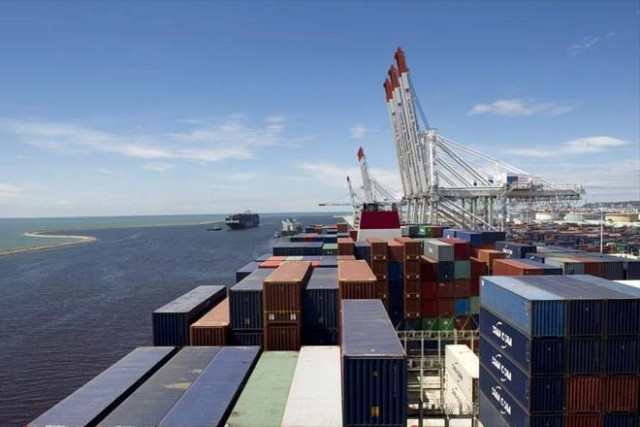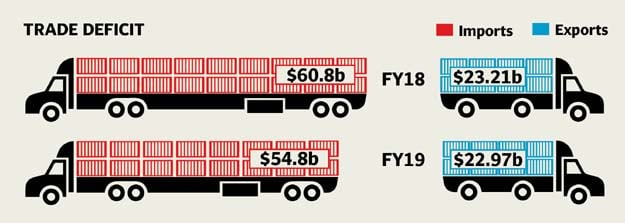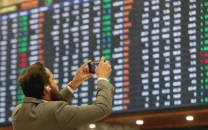Trade deficit shrinks 15.3% to $31.8b in FY19
Gap narrows due to import compression while exports cannot be lifted

Representational image. PHOTO: REUTERS
Trade figures released by the Pakistan Bureau of Statistics (PBS) on Friday showed that exports contracted both on month-on-month and year-on-year basis in June despite over one-third depreciation of the rupee against the US dollar. The PTI government missed its export target by $4 billion as total exports stood below $23 billion at the end of fiscal year 2018-19.
It also missed the trade deficit reduction target by $5.8 billion, although the gap between exports and imports shrank 15.3%.
Overall, the trade deficit, which stood at $37.6 billion in the preceding fiscal year, shrank to $31.8 billion in the just ended fiscal year 2018-19, the PBS reported. In absolute terms, there was a reduction of $5.8 billion in the trade deficit and the entire reduction came from the import side.
Overall imports dropped 9.9% to $54.8 billion in FY19 but the improvement was mainly because of reduction in machinery imports. In absolute terms, the imports contracted by $6 billion, which provided some relief to the government.
Trade deficit of Pakistan - a vicious cycle
However, the real challenge remained the exports, which registered a negative growth of 1% and stood at only $22.97 billion, remaining shy of even $23 billion, during the previous fiscal year. In absolute terms, the exports shrank $234 million.
Adviser to Prime Minister on Commerce Abdul Razak Dawood had vowed to enhance exports to $27 billion on the back of steep currency depreciation and market access to China. However, it did not happen.
Dawood had claimed that Chinese market access would boost exports by an additional $1 billion during fiscal year 2018-19.
Exporters have long been getting subsidised loans, electricity and gas, and are exempted from the normal income tax regime. The central bank has let the currency depreciate by over 40% in a bid to give a boost to exports and curb imports.
The PTI government has provided over Rs30-billion package in the shape of lower gas and electricity prices.
State Bank of Pakistan Governor Dr Reza Baqir said on Thursday there was a need to support the exporters by making them competitive. But “the exchange rate is not the ultimate solution and the ultimate solution has to come from the business by improving competitiveness.”

The government wanted to cut the trade deficit to $26 billion, but it missed the goal by a wide margin of $5.8 billion. The value of export goods was 239% less than the value of imports.
The failure to achieve the export target and reduce the trade deficit to the desired level has made it challenging to meet new fiscal year’s trade targets.
For the new fiscal year, the government has set the export target at $26.8 billion, which will require 16.6% growth. Imports in the new fiscal year are projected to contract 5.5% to $51.8 billion.
The trade deficit is also targeted to be reduced to $24.9 billion in fiscal year 2019-20, a contraction of 21.7%.
The trade balance in June this year as compared to the same month a year ago improved but only because of compression of imports. The trade deficit shrank 29.8% from $3.8 billion to $2.7 billion in June. In absolute terms, there was a reduction of $1.1 billion on an annual basis.
In June 2019, the imports in dollar terms fell to $4.4 billion compared to $5.7 billion in the same month of last year, which reflected contraction of over 22.8%, reported the PBS. But exports also decreased 8.8% to $1.7 billion in June, a net reduction of $165 million.
On a month-on-month basis, the exports fell 18.3% in June over the preceding month. There was a loss of $385 million in export receipts as compared to the preceding month. The imports also posted negative growth of 13.5% to $4.4 billion last month.
Resultantly, the trade deficit contracted one-tenth to $2.6 billion in June over May.
Published in The Express Tribune, July 13th, 2019.
Like Business on Facebook, follow @TribuneBiz on Twitter to stay informed and join in the conversation.

















COMMENTS
Comments are moderated and generally will be posted if they are on-topic and not abusive.
For more information, please see our Comments FAQ